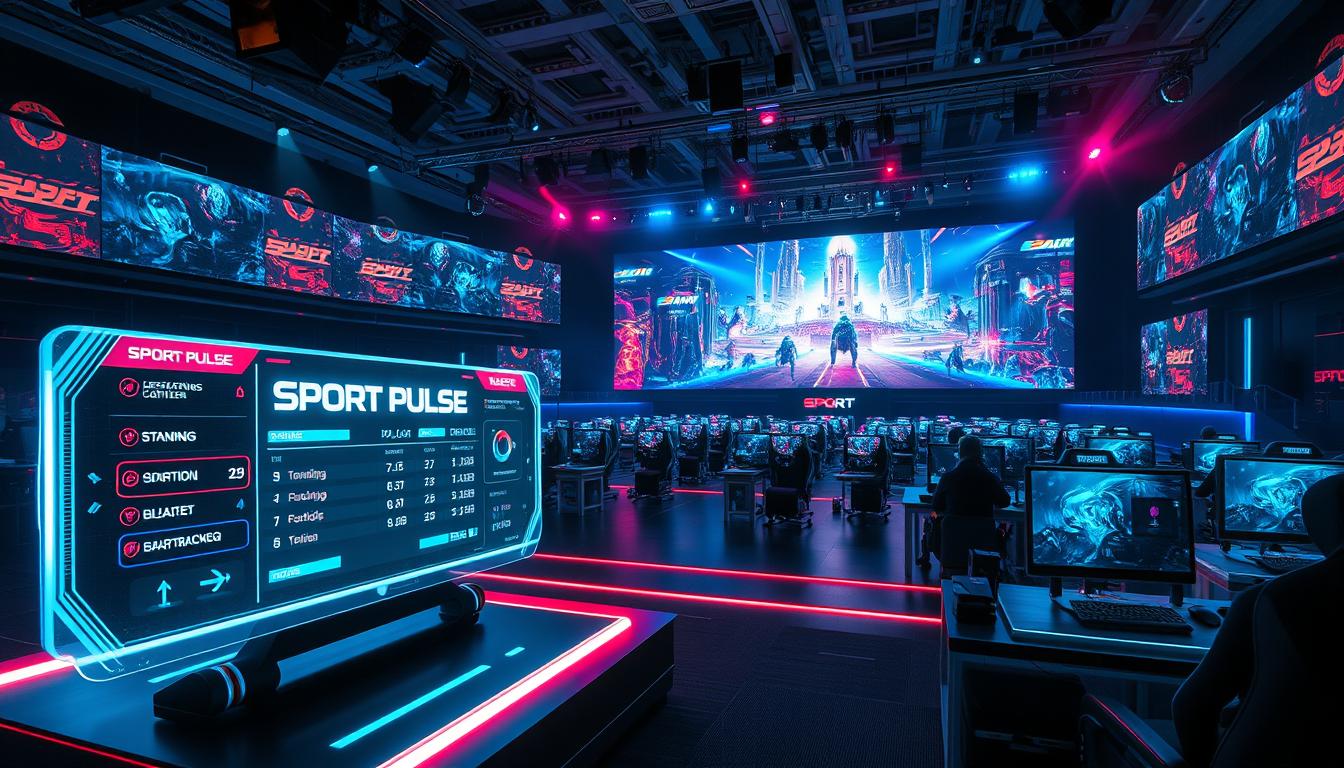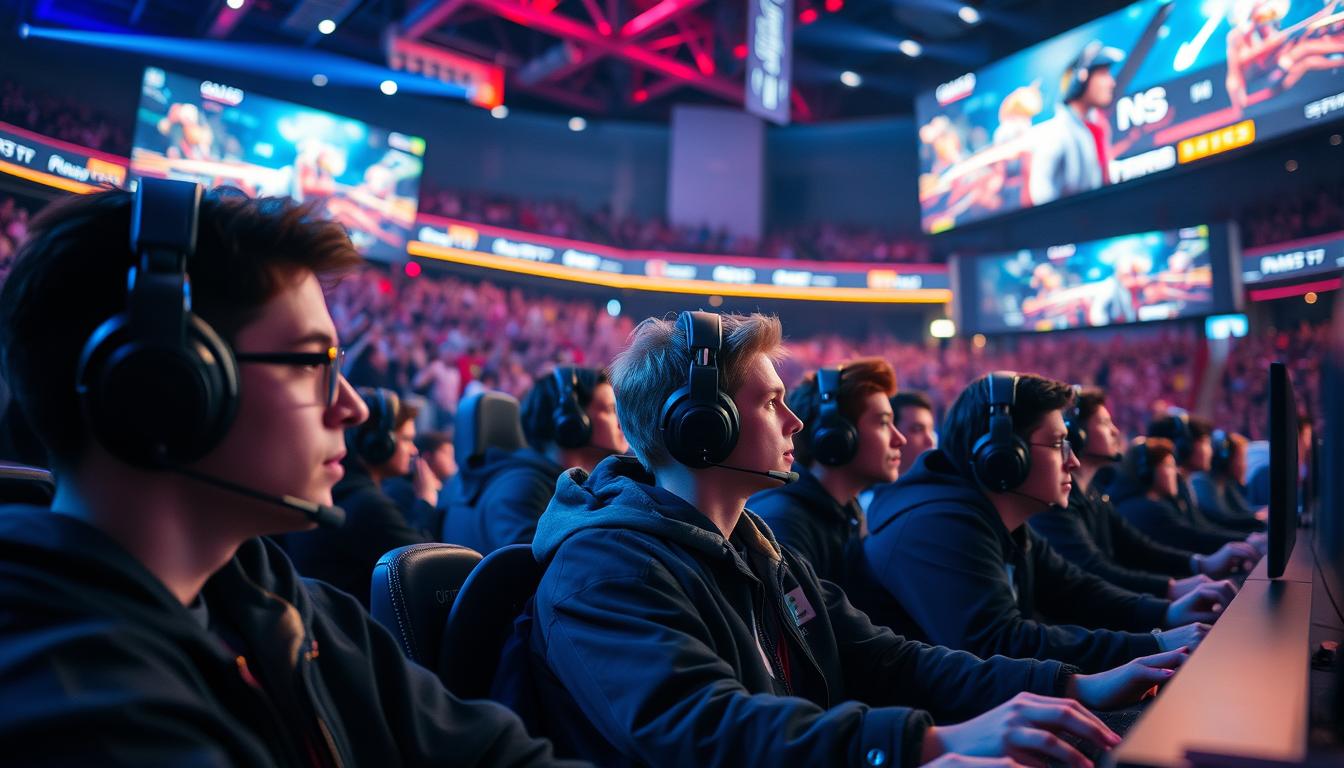Did you know 75% of today’s professional gamers rely on hardware that didn’t exist five years ago? From AI-driven coaching tools to ultra-responsive peripherals, the industry evolves faster than a speedrun. What started as basement LAN parties now drives a $200 billion global market—and we’re just getting started.
We’re diving into how innovations like neural interfaces and cloud-based tournaments are rewriting the rules. Remember when split-screen multiplayer felt revolutionary? Today’s players compete across continents with zero lag, thanks to 5G and edge computing.
Data isn’t just for scoreboards anymore. Real-time analytics help teams optimize strategies mid-match, while streaming platforms turn every game into a spectator event. This isn’t just play—it’s a high-stakes ecosystem where milliseconds decide careers.
Key Takeaways
- Global gaming revenue now rivals Hollywood and the music industry combined
- Cutting-edge hardware reduces input lag by up to 90% compared to 2019 models
- Live-streamed esports events attract larger audiences than the Super Bowl
- Machine learning tools analyze player patterns to predict winning strategies
- Next-gen VR arenas are blurring the line between physical and digital competition
Introduction to Competitive Gaming Trends
Imagine controllers that learn your playstyle before you finish the tutorial. That’s where we’re headed. The gaming landscape has transformed from clunky arcade cabinets to arenas where split-second decisions make careers. What changed? Systems evolved to prioritize speed, precision, and community.
From Pixels to Powerhouses
Early games relied on simple code and joysticks. Today’s titles use machine learning to adapt to players. The business side exploded too—streaming services turned casual matches into global spectacles. Check out how key developments reshaped the field:
| Era | Hardware | Software | Connectivity |
|---|---|---|---|
| 1980s | 8-bit consoles | Basic 2D graphics | Local multiplayer only |
| 2000s | HD-ready PCs | 3D rendering engines | Broadband online play |
| 2020s | AI-enhanced gear | Real-time data analytics | 5G cloud tournaments |
Tech’s Role in Redefining Play
Why does this matter? Better technology means fairer matches and smarter training tools. Developers now use player data to balance game mechanics—no more overpowered characters ruining leaderboards. Services like cross-platform saves let you switch devices without losing progress.
Industries beyond gaming took notice. Sports teams borrow esports coaching methods, while schools use game design principles to teach coding. The line between “player” and “creator” keeps blurring, thanks to mod-friendly platforms.
The Evolution of Gaming: Past to Present Technology
Gaming’s journey from beeping arcades to AI-powered arenas reshaped entertainment forever. Early systems like the Magnavox Odyssey (1972) couldn’t display scores—players tracked points manually. Today’s tech handles 4K visuals at 120 frames per second while analyzing gameplay in real time.
Historic Milestones and Innovations
Breakthroughs in computing power fueled gaming’s evolution. The 1980s saw cartridges store game data, while the 2000s introduced physics engines for realistic movement. Recent leaps include cloud streaming and neural networks that adapt to player behavior.
| Innovation | Year | Impact |
|---|---|---|
| First home console | 1972 | Brought gaming to living rooms |
| Online multiplayer | 1996 | Connected global players |
| Cloud gaming | 2010 | Eliminated hardware limits |
Gaming Innovations in Numbers
The industry grew from $60 billion in 2021 to a projected $220 billion by 2024. Over 3 billion players now engage with games worldwide—a 40% jump since 2018. Modern GPUs process data 1,000x faster than 2010 models, cutting load times by 70%.
Advancements in console market evolution show how systems now balance raw power with energy efficiency. Developers use machine learning to refine game mechanics, creating worlds that react to player choices instantly.
Future Gaming Innovations Driven by Gesture, Facial, and Voice Recognition
What if your smile could unlock in-game rewards? We’re entering an era where controllers gather dust as players command characters through body language alone. Natural interaction systems now interpret subtle movements, vocal tones, and even facial micro-expressions to create seamless gameplay.
Gesture Control and Natural Interaction
Intel’s 3D cameras track 22 joint movements simultaneously, letting players dodge virtual obstacles by leaning sideways. Developers use this data to build games that respond to martial arts stances or dance moves. One rhythm title adjusts difficulty based on how precisely you mimic on-screen choreography.
Facial recognition isn’t just for logins anymore. Games like Avatar Legends scan your expressions to customize characters that mirror your smirk or eyebrow raise. Machine learning models refine these systems by studying thousands of user interactions, making avatars eerily lifelike.
Voice Recognition: Enhancing Accessibility in Gaming
“Heal squad!” shouts a player, and their team instantly regenerates. Voice commands empower gamers with mobility challenges to execute complex actions through speech. Over 40% of Xbox titles now support vocal input for menu navigation or strategy calls.
These tools also break language barriers. Real-time translation processing lets multilingual squads collaborate smoothly. As one developer noted: “We’re not just building games—we’re crafting inclusive worlds.”
With machine learning refining accuracy, these innovations will soon feel as natural as grabbing a joystick. Expect VR headsets that read lip movements and AR interfaces controlled by eye blinks. The future of play lies in technologies that disappear, leaving pure immersion.
Leveraging Cutting-Edge Graphics and High-Definition Displays
Remember when game characters looked like blocky pixels? Modern titles now render eyelash textures and dynamic weather patterns with shocking clarity. This visual revolution isn’t just about prettier games—it’s redefining how players connect with virtual worlds.
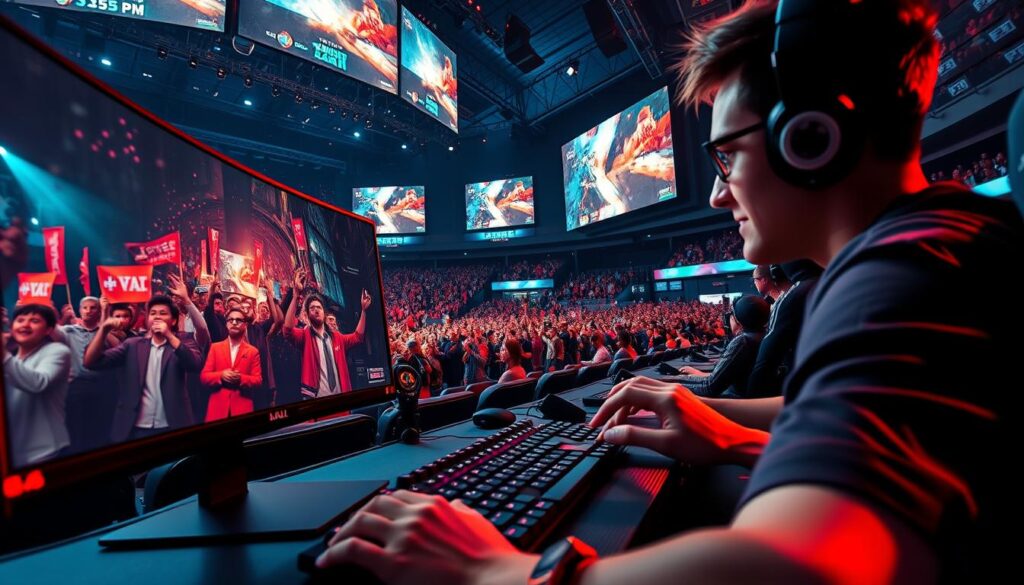
The Shift to Photorealistic 3D Graphics
Today’s GPUs process 16 million polygons per frame, crafting environments indistinguishable from reality. Developers use ray tracing to simulate light bouncing off surfaces naturally. One racing game’s rain effects took 18 months to perfect—each droplet interacts with car physics authentically.
Advances in computing efficiency make this possible. New rendering systems reduce GPU strain by 40% while boosting detail. Games like Eclipse Horizon showcase fabrics that wrinkle as characters move, thanks to machine learning algorithms trained on real-world data.
Benefits of HD, Quad HD, and 4K Displays
Higher resolutions expose details most players never noticed. At 4K, distant sniper scopes glint in sunlight, giving competitive advantages. Check how display upgrades enhance gameplay:
| Resolution | Pixel Count | Response Time |
|---|---|---|
| HD (1080p) | 2 million | 5ms |
| Quad HD | 3.7 million | 3ms |
| 4K | 8.3 million | 1ms |
These leaps demand tech partnerships. Display makers collaborate with game studios to optimize color accuracy and refresh rates. As one designer put it: “We’re not just building screens—we’re engineering windows into other dimensions.”
The push for visual perfection shapes content creation pipelines. Artists now craft assets at 8K resolution, ensuring crispness across all devices. While storage demands grow, compression systems maintain performance without sacrificing quality.
NFT Game Development and the Rise of the Play-to-Earn Economy
What if your gaming skills could pay your bills? NFT-driven titles now let players earn real-world value through digital ownership. Our analysis shows this business model generated $3.4 billion in 2023, with investment pouring into blockchain-based platforms.
At its core, NFT technology transforms in-game items into tradeable assets. Players battle for rare swords or virtual land, then sell them on marketplaces. Developers earn royalties from secondary sales—a win-win solution reshaping revenue streams.
Key factors driving growth:
- Global market for play-to-earn games projected to hit $88 billion by 2028
- Major studios integrating blockchain solutions into existing franchises
- Secure wallet systems preventing asset theft through advanced cybersecurity
Security remains critical. Leading titles use:
- Multi-signature authentication
- Encrypted transaction ledgers
- Real-time fraud detection
Games like Axie Infinity and Decentraland prove the model works. One player earned $60,000 selling NFT creatures—enough to start their own gaming business. As one developer told us: “We’re building economies, not just entertainment.”
The market evolves rapidly. Expect more hybrid models blending competitive play with decentralized finance. Your next headshot might fund your next car payment.
Augmented Reality and Virtual Reality: Creating Extended Reality in Gaming
Picture this: your morning jog becomes a monster hunt, and your living room transforms into a spaceship cockpit. This blend of physical and digital worlds defines extended reality gaming—where augmented reality layers fantasy onto sidewalks, while virtual reality builds entirely new universes.
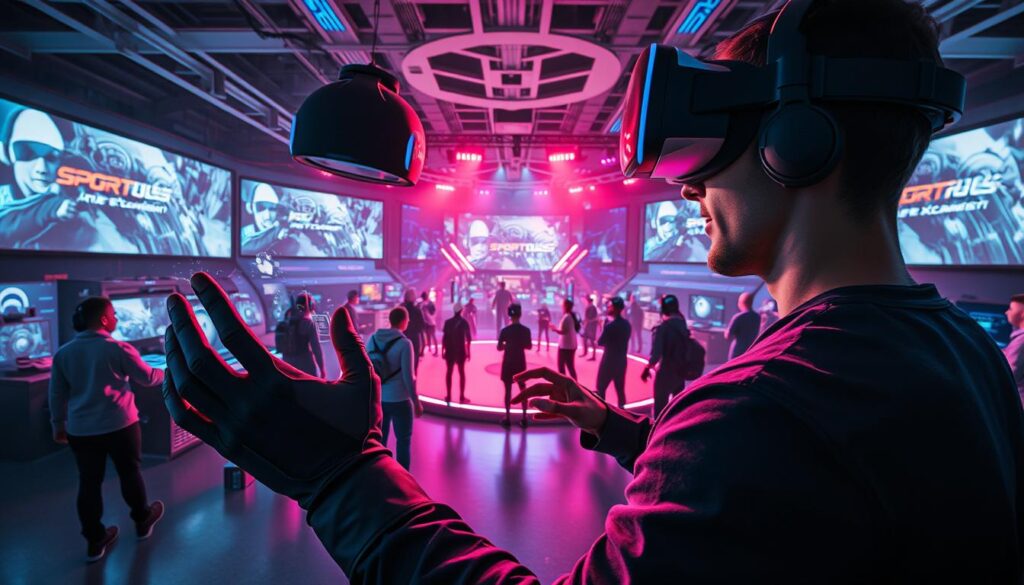
Immersive AR Experiences for Interactive Play
Mobile games like Pokémon Go proved AR’s potential, but today’s applications go further. Architects now design games where players rearrange virtual furniture in real rooms using phone cameras. Educational titles overlay historical battles onto school playgrounds, turning recess into learning adventures.
Key advancements driving AR growth:
- Smartphone LiDAR scanners mapping environments in milliseconds
- Cloud computing processing complex spatial data
- Multiplayer modes letting friends see the same holograms
Traversing New Digital Worlds
VR headsets like Valve Index achieve what earlier technology couldn’t—true presence. Players feel vertigo on virtual cliffs and instinctively duck from flying debris. Fitness games track full-body motion, burning calories while slaying dragons.
The latest platforms leverage:
- Eye-tracking for intuitive menu navigation
- Haptic gloves simulating texture and weight
- Machine learning algorithms predicting motion sickness
Extended reality isn’t just changing games—it’s redefining human interaction. As computing power grows, expect AR/VR hybrids where digital objects obey real-world physics. The XR market could hit $100 billion by 2026, proving players crave experiences that transcend screens.
Cloud Gaming and Cross-Platform Experiences Transforming Play
What if your gaming rig fit in your pocket? Cloud computing makes this possible, streaming AAA titles to phones and tablets. Services like Nvidia’s GeForce NOW process games on remote servers, delivering console-quality play without $2,000 PCs. This shift democratizes access—74% of new players now start gaming through cloud platforms.
Cloud Infrastructure: Enhancing Playability
Modern cloud systems eliminate hardware barriers. Games render on enterprise-grade GPUs miles away, while your device acts as a smart display. Latency? Down to 12ms with 5G networks. Check how cloud specs compare to traditional setups:
| Feature | Local Gaming PC | Cloud Service |
|---|---|---|
| Cost | $1,500+ | $10/month |
| Updates | Manual downloads | Instant deployment |
| Access | Single location | Any 5G device |
Developers leverage this technology to scale games dynamically. Battle royale matches now support 500+ players without lag—something impossible on home consoles. As one engineer noted: “We’re building stadiums in the sky.”
The Advantages of Cross-Platform Compatibility
Your progress shouldn’t reset when switching devices. Cross-platform integration lets Xbox players team up with PlayStation rivals, while mobile users join PC lobbies. Key benefits include:
- Unified friend lists across platforms
- Shared achievements and inventory
- Faster matchmaking through combined player pools
Behind the scenes, API solutions synchronize data between ecosystems. Games like Fortnite use these tools to maintain 100 million monthly active users. The cross-platform development market will grow 28% annually through 2027—proof players crave connected experiences.
Together, cloud services and cross-device play erase old boundaries. Your skills—not your hardware—become the ultimate advantage.
Offline Gaming Apps: Bridging Connectivity Gaps in Competitive Play
Reliable gaming shouldn’t depend on Wi-Fi signals. While online multiplayer dominates headlines, millions still rely on apps that work anywhere—subway tunnels, remote cabins, or mid-flight. These solutions keep players engaged when networks fail or data plans run dry.
Why Offline Gaming Remains Relevant
Nearly 40% of mobile gamers prefer titles that don’t require constant internet. Why? Offline modes eliminate lag spikes and server crashes. They also cater to users in regions with spotty broadband access. Developers now design content that adapts to both high-end and budget devices.
Check how offline features compare to online counterparts:
| Feature | Offline Games | Online Games |
|---|---|---|
| Accessibility | Play anywhere | Requires stable connection |
| Updates | Manual download | Automatic patches |
| Monetization | One-time purchase | In-app purchases |
Major platforms like Google Play prioritize offline-capable titles in their editorial picks. Games like Alto’s Odyssey and Monument Valley maintain top charts years after launch. Their secret? Tight gameplay loops that work without cloud saves or live leaderboards.
Business strategies evolve too. Studios bundle offline modes with premium subscriptions, creating hybrid services. As one designer noted: “We’re not just building games—we’re crafting reliable escapes.”
Advancements in technology help here. New engines optimize storage usage, letting complex titles run on entry-level phones. This development approach ensures seamless experiences across devices, keeping users engaged during commutes or travel.
Advanced Blockchain and Cybersecurity in Gaming
How much would you pay to protect your virtual sword? With rare in-game items now fetching six-figure sums, security has become gaming’s new endgame. Blockchain technology and advanced cybersecurity measures now guard digital treasures with military-grade precision.
Securing Digital Transactions and In-Game Assets
Modern games use decentralized ledgers to lock down ownership records. Every NFT sword or skin gets a unique blockchain fingerprint—tamper-proof and permanently traceable. Popular titles like Gods Unchained process 50,000+ secure trades daily using this software backbone.
Three layers protect today’s gaming ecosystems:
| Protection Type | Traditional | Blockchain |
|---|---|---|
| Asset Tracking | Central servers | Distributed ledger |
| Fraud Prevention | Manual reviews | Smart contracts |
| Data Storage | Company databases | User-controlled wallets |
New cybersecurity tools go beyond theft prevention. Biometric logins and AI threat detection now shield accounts. One racing game developer reduced hacking attempts by 89% after implementing real-time behavior analysis.
Players aren’t the only beneficiaries. Studios use these security systems to build trust—and profits. As one platform architect told us: “Secure development practices turned skeptics into paying customers overnight.”
The stakes keep rising. With gaming economies rivaling small nations’ GDPs, robust cybersecurity isn’t optional—it’s the price of admission.
Top Trends, Breakthrough Tech, and the Future of Competitive Play
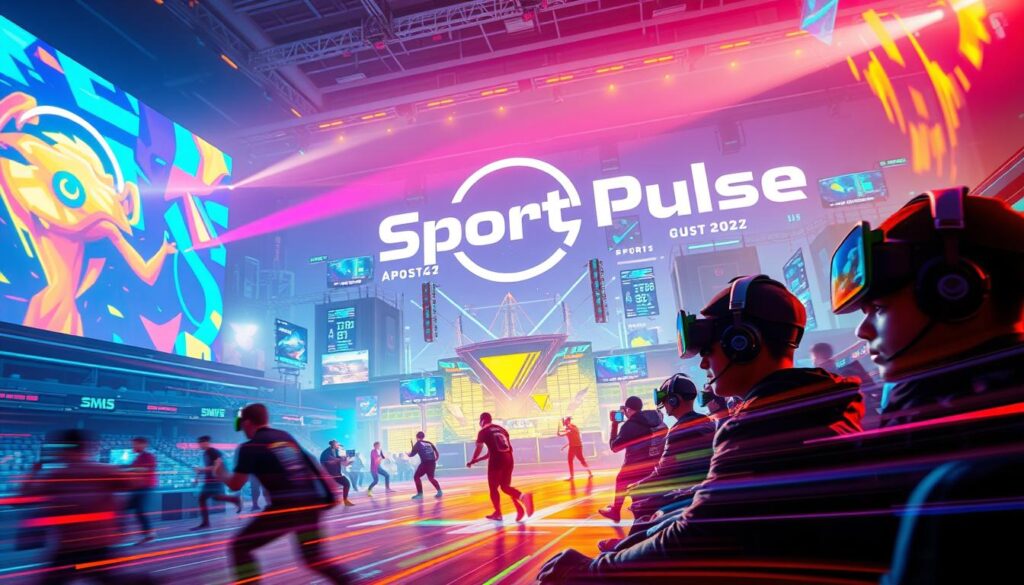
Gaming’s next evolution hinges on three seismic shifts. Neural interfaces could let players control characters through brainwaves by 2026—trials show 30% faster reaction times versus traditional controls. Cloud infrastructure now supports tournaments with 10,000+ simultaneous participants, breaking physical venue limitations.
We’re seeing radical changes in how games create value:
- Blockchain-backed items generated $4.7B in Q1 2024 trades
- AI coaches improve player win rates by 22% through match analysis
- 5G arenas enable real-time translation for international squads
Investment patterns reveal priorities. Venture funding for haptic feedback systems jumped 140% last year, while AR training simulators attracted $900M in military contracts. As one league commissioner told us: “Tomorrow’s champions will train in digital twins of actual tournaments.”
| Current Capability | 2026 Projection | Growth Factor |
|---|---|---|
| 4K/120fps streaming | 8K/240fps | 4x |
| 10ms input lag | 3ms | 70% reduction |
| 1M concurrent viewers | 5M | 5x |
These advancements create new career paths beyond playing. Data scientists now optimize team strategies using biometrics from wearable sensors. Meanwhile, interactive streaming platforms let fans influence live matches through voting systems—blurring lines between audience and competitor.
The race for immersion reshapes hardware development. Next-gen controllers may track muscle tension to detect fatigue, while VR headsets simulate weather effects through temperature changes. As infrastructure evolves, so do opportunities—proving innovation remains gaming’s ultimate power-up.
The Role of Edge and Cloud-Based Technologies in Enhancing Gaming Experiences
Milliseconds decide championships in today’s esports arena. Edge computing tackles this challenge by processing game data closer to players, slashing latency to near-zero levels. Combined with cloud technology, these systems deliver seamless performance whether you’re battling in Tokyo or Texas.
Real-Time Response Revolution
Traditional cloud gaming routes data through distant servers. Edge computing flips this model—local nodes handle inputs like character movements instantly. A fighting game’s frame-perfect combo now responds in 3ms instead of 25ms. Pro players report 18% faster reaction times in edge-powered tournaments.
Key integration benefits between edge and cloud:
| Edge Role | Cloud Role |
|---|---|
| Instant input processing | Long-term match analytics |
| Regional server optimization | Global player matchmaking |
| Latency-sensitive actions | Machine learning model training |
Developers use machine learning to predict player actions before they happen. One racing game’s AI anticipates steering adjustments 200ms early, smoothing gameplay. These models train on cloud-stored data but deploy via edge nodes for real-time execution.
Real-world impacts are measurable. A popular MOBA reduced lag spikes by 45% after implementing edge processing. Cross-platform integration became smoother too—Xbox and PC players now share matches without synchronization issues. As one tournament organizer noted: “Edge tech turned regional events into global spectacles overnight.”
Integrating Next-Level Automation and AI in Game Development
What separates a good game from a legendary one? Adaptive worlds that learn from players. Modern studios now use machine learning to craft experiences that evolve with every decision, turning static code into living ecosystems.

Smart Systems, Smarter Play
Games like Dynamic Realms deploy neural networks that analyze 200+ player metrics per second. These models adjust enemy tactics mid-battle, creating opponents that counter your unique style. One survival title’s AI director modifies weather patterns based on squad coordination levels—push too hard, and thunderstorms sabotage your plans.
Key innovations reshaping development:
- Procedural content generators building unique levels in milliseconds
- Real-time data processing that personalizes difficulty curves
- NPCs with conversational AI mimicking human improvisation
Developers report 60% faster testing cycles using automated bug detection. Tools like AutoBalance AI tweak character stats across millions of simulated matches before updates go live. As one studio head shared: “Our machine learning pipeline spots imbalances human testers miss 90% of the time.”
The AI-driven multiplayer game development wave extends beyond mechanics. Narrative engines now branch stories based on voice tone analysis, while cloud-based learning systems crowdsource balance adjustments from global player bases. Tomorrow’s games won’t just challenge your skills—they’ll study your soul.
The Influence of Emerging Tech on Game Development Investment and Revenue Growth
What separates a booming industry from a stagnant one? Strategic bets on innovation. Gaming’s revenue is projected to hit $320 billion by 2026, fueled by breakthroughs in AI, cloud infrastructure, and immersive interfaces. Investors are funneling capital into studios that blend cutting-edge tech with scalable business models.
Market Projections and Revenue Trends
Recent data reveals venture funding for gaming companies jumped 67% year-over-year. Why? Emerging tools like generative AI slash development costs while accelerating content creation. Studios using these systems report 40% faster production cycles and 22% higher player retention.
Key sectors driving market expansion:
| Tech Sector | 2023 Revenue | 2026 Projection | Growth Rate |
|---|---|---|---|
| AR/VR | $12B | $45B | 275% |
| Cloud Gaming | $4.8B | $18B | 275% |
| AI Development | $2.1B | $9.3B | 343% |
| Blockchain | $3.4B | $14B | 312% |
Major companies like Epic Games and Unity now allocate 30% of R&D budgets to neural networks and real-time analytics. Their success proves a clear pattern: investment in tech directly correlates with revenue spikes. Take Niantic’s AR platform—its partnerships with brands boosted annual earnings by 58%.
“You can’t win tomorrow’s market with yesterday’s tools,” notes a leading business strategist. As player expectations evolve, studios must prioritize investment in adaptive systems. The payoff? Dominance in an industry where development agility defines long-term survival.
The Impact of New Tech Trends on Competitive Gaming Business Models
By 2025, 60% of gaming revenue will come from business models that didn’t exist three years prior. Players now expect customizable experiences, instant updates, and cross-platform flexibility—demands that push studios to rethink monetization and engagement strategies.

Adapting to Evolving Consumer Preferences
Today’s gamers prioritize accessibility over ownership. Subscription services like Xbox Game Pass grew 234% since 2021, proving players prefer vast libraries over single purchases. Developers face dual challenges:
- Balancing free-to-play mechanics with sustainable revenue
- Integrating technology that supports personalized gameplay
- Maintaining competitive fairness across hybrid models
Cross-platform integration reshapes revenue streams. Games allowing PC-to-mobile progression see 70% higher retention rates. Meanwhile, AI-driven dynamic pricing adjusts in-game item costs based on real-time demand—a tactic boosting profits by 18% for early adopters.
Design choices now directly impact profitability. Studios using player behavior data to refine loot box systems report 40% fewer refund requests. As one executive noted: “We’re not just coding games—we’re architecting economies.”
The industry’s future belongs to agile businesses. Those blending emerging tech with user-centric development will dominate, while rigid studios risk obsolescence. Adaptability isn’t optional—it’s survival.
Staying Connected: Contact and Consultation for Gaming Innovation
Ready to turn gaming insights into action? Our team bridges the gap between industry knowledge and real-world solutions. Whether you’re refining a platforms strategy or exploring emerging technology, we offer tailored guidance for every stage.
WhatsApp For More Info: +44-7822010953
Connect directly via WhatsApp for instant responses to your queries. We provide:
- Personalized consultations on services integration
- Up-to-date information on regulatory changes
- Technical support for cross-platform development
Our experts analyze user behavior patterns to recommend solutions that boost engagement. Check how different contact methods compare:
| Method | Response Time | Availability |
|---|---|---|
| Under 15 minutes | 24/7 | |
| 4 business hours | Weekdays | |
| Live Chat | Instant | 9 AM – 9 PM GMT |
Stay ahead with weekly information briefs covering VR integration tactics and cloud optimization strategies. We’ve helped 150+ studios enhance their services through data-driven adjustments.
“Collaboration fuels innovation—let’s build gaming’s next chapter together.” Reach out today to discuss custom solutions for your project’s unique needs.
Conclusion
As we wrap up our journey through gaming’s evolution, one truth stands clear: transformation drives this industry. From AI-powered coaching tools to blockchain-backed economies, emerging technology reshapes how we play, compete, and connect. The numbers speak for themselves—global revenue now rivals Hollywood, while cloud platforms democratize access for billions.
Key trends reveal a future where innovation never sleeps. Neural interfaces could replace controllers, while real-time data analytics refine strategies mid-match. These advancements aren’t just upgrades—they’re complete reinventions of what gaming can achieve.
What comes next? Expect immersive worlds that adapt to your heartbeat and tournaments spanning continents without lag. The line between virtual and physical arenas will keep fading, creating opportunities we’ve only begun to imagine.
Stay curious. Follow developments in haptic feedback systems and decentralized gaming economies. Share your thoughts as these transformations unfold—we’re all players in this rapidly evolving landscape.
Thanks for exploring tomorrow’s gaming frontiers with us. Here’s to the next level!
